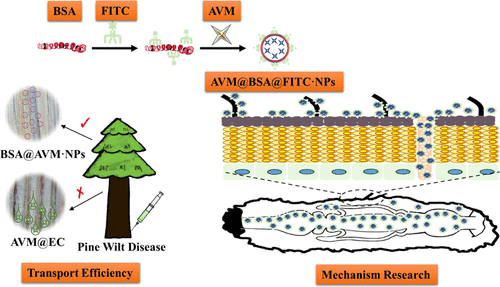当前位置:
X-MOL 学术
›
ACS Sustain. Chem. Eng.
›
论文详情
Our official English website, www.x-mol.net, welcomes your
feedback! (Note: you will need to create a separate account there.)
Fluorescence-Labeled Abamectin Nanopesticide for Comprehensive Control of Pinewood Nematode and Monochamus alternatus Hope
ACS Sustainable Chemistry & Engineering ( IF 7.1 ) Pub Date : 2020-10-28 , DOI: 10.1021/acssuschemeng.0c05771 Chenyu Su 1 , Yingchao Ji 1, 2 , Shanshan Liu 1 , Shangkun Gao 1, 2 , Shenghan Cao 1 , Xiaoyu Xu 1 , Chenggang Zhou 1, 2 , Yanxue Liu 3
ACS Sustainable Chemistry & Engineering ( IF 7.1 ) Pub Date : 2020-10-28 , DOI: 10.1021/acssuschemeng.0c05771 Chenyu Su 1 , Yingchao Ji 1, 2 , Shanshan Liu 1 , Shangkun Gao 1, 2 , Shenghan Cao 1 , Xiaoyu Xu 1 , Chenggang Zhou 1, 2 , Yanxue Liu 3
Affiliation

|
Pine wilt disease is a major forestry quarantine disease caused by pinewood nematode and spread by the vector insect Monochamus alternatus (MA), which has brought destructive harm to pine trees. Avermectin (AVM) is a broad-spectrum fungicide, insecticide, and nematicide. However, AVM easily degrades under ultraviolet light and is almost insoluble in water, which seriously affect its control effect on the pine wilt disease. In this study, an original nanopesticide was designed to improve the bioactivity and utilization of AVMactive ingredients, with antiphotolysis and slow release properties especially. Bovine serum albumin (BSA) was dissolved in water, taking advantage of the oleophobic properties of the protein to wrap AVM in an oil phase by self-assembly. The obtained AVM BSA nanoparticles (AVM@BSA·NPs) had preferable sustained-release performance, the cumulative release reached 90.2%, the nanoparticles could be released continuously for about 20 days, the particle size of the AVM@BSA·NPs was about 65 nm, and the loading efficiency reached 78%. The nanodelivery system could effectively protect AVM from photolysis, and the retention of AVM@BSA·NPs was close to 80 and 75% after 48 and 72 h under ultraviolet light, respectively. In addition, the nanopesticides were prepared by labeling AVM@BSA·NPs with fluorescein isothiocyanate (FITC) to research the mechanism of contact and stomach toxicity of AVM using the probe function of FITC. Compared with AVM original, the stomach toxicity and contact toxicity of AVM@BSA·NPs increased by 35.3 and 19.6%, respectively. There are broad application prospects of AVM@BSA·NPs for the prevention and control of forest diseases and other pests.
中文翻译:

荧光标记的阿维菌素Nanopesticide为我国松材线虫的综合治理和松墨天牛的希望
松树枯萎病是由松材线虫引起的主要森林检疫病,由媒介昆虫松墨褐天牛传播(MA),对松树造成了破坏性伤害。阿维菌素(AVM)是一种广谱杀菌剂,杀虫剂和杀线虫剂。但是,AVM在紫外线下容易降解,几乎不溶于水,这严重影响了其对松萎病的防治效果。在这项研究中,设计了一种原始的纳米农药来改善AVMactive成分的生物活性和利用率,特别是具有抗光解和缓释特性。将牛血清白蛋白(BSA)溶解在水中,利用该蛋白的疏油特性,通过自组装将AVM包裹在油相中。所获得的AVM BSA纳米颗粒(AVM @ BSA·NPs)具有较好的缓释性能,累积释放达到90.2%,纳米颗粒可以连续释放约20天,AVM @ BSA·NPs的粒径约为65 nm,负载效率达到78%。纳米递送系统可以有效地保护AVM免受光解,在紫外线照射48h和72h后,AVM @ BSA·NPs的保留率分别接近80%和75%。此外,通过用异硫氰酸荧光素(FITC)标记AVM @ BSA·NPs制备纳米农药,以利用FITC的探针功能研究AVM的接触和胃毒性机制。与原始AVM相比,AVM @ BSA·NPs的胃毒性和接触毒性分别增加了35.3和19.6%。AVM @ BSA·NPs在森林病虫害的防治中具有广阔的应用前景。纳米递送系统可以有效地保护AVM免受光解,在紫外线照射48h和72h后,AVM @ BSA·NPs的保留率分别接近80%和75%。此外,通过用异硫氰酸荧光素(FITC)标记AVM @ BSA·NPs制备纳米农药,以利用FITC的探针功能研究AVM的接触和胃毒性机制。与原始AVM相比,AVM @ BSA·NPs的胃毒性和接触毒性分别增加了35.3和19.6%。AVM @ BSA·NPs在森林病虫害的防治中具有广阔的应用前景。纳米递送系统可以有效地保护AVM免受光解,在紫外线照射48h和72h后,AVM @ BSA·NPs的保留率分别接近80%和75%。此外,通过用异硫氰酸荧光素(FITC)标记AVM @ BSA·NPs制备纳米农药,以利用FITC的探针功能研究AVM的接触和胃毒性机制。与原始AVM相比,AVM @ BSA·NPs的胃毒性和接触毒性分别增加了35.3和19.6%。AVM @ BSA·NPs在森林病虫害的防治中具有广阔的应用前景。用异硫氰酸荧光素(FITC)标记AVM @ BSA·NPs,制备纳米农药,利用FITC的探针功能研究AVM的接触毒性和胃毒性。与原始AVM相比,AVM @ BSA·NPs的胃毒性和接触毒性分别增加了35.3和19.6%。AVM @ BSA·NPs在森林病虫害的防治中具有广阔的应用前景。用异硫氰酸荧光素(FITC)标记AVM @ BSA·NPs,制备纳米农药,利用FITC的探针功能研究AVM的接触毒性和胃毒性。与原始AVM相比,AVM @ BSA·NPs的胃毒性和接触毒性分别增加了35.3和19.6%。AVM @ BSA·NPs在森林病虫害的防治中具有广阔的应用前景。
更新日期:2020-10-28
中文翻译:

荧光标记的阿维菌素Nanopesticide为我国松材线虫的综合治理和松墨天牛的希望
松树枯萎病是由松材线虫引起的主要森林检疫病,由媒介昆虫松墨褐天牛传播(MA),对松树造成了破坏性伤害。阿维菌素(AVM)是一种广谱杀菌剂,杀虫剂和杀线虫剂。但是,AVM在紫外线下容易降解,几乎不溶于水,这严重影响了其对松萎病的防治效果。在这项研究中,设计了一种原始的纳米农药来改善AVMactive成分的生物活性和利用率,特别是具有抗光解和缓释特性。将牛血清白蛋白(BSA)溶解在水中,利用该蛋白的疏油特性,通过自组装将AVM包裹在油相中。所获得的AVM BSA纳米颗粒(AVM @ BSA·NPs)具有较好的缓释性能,累积释放达到90.2%,纳米颗粒可以连续释放约20天,AVM @ BSA·NPs的粒径约为65 nm,负载效率达到78%。纳米递送系统可以有效地保护AVM免受光解,在紫外线照射48h和72h后,AVM @ BSA·NPs的保留率分别接近80%和75%。此外,通过用异硫氰酸荧光素(FITC)标记AVM @ BSA·NPs制备纳米农药,以利用FITC的探针功能研究AVM的接触和胃毒性机制。与原始AVM相比,AVM @ BSA·NPs的胃毒性和接触毒性分别增加了35.3和19.6%。AVM @ BSA·NPs在森林病虫害的防治中具有广阔的应用前景。纳米递送系统可以有效地保护AVM免受光解,在紫外线照射48h和72h后,AVM @ BSA·NPs的保留率分别接近80%和75%。此外,通过用异硫氰酸荧光素(FITC)标记AVM @ BSA·NPs制备纳米农药,以利用FITC的探针功能研究AVM的接触和胃毒性机制。与原始AVM相比,AVM @ BSA·NPs的胃毒性和接触毒性分别增加了35.3和19.6%。AVM @ BSA·NPs在森林病虫害的防治中具有广阔的应用前景。纳米递送系统可以有效地保护AVM免受光解,在紫外线照射48h和72h后,AVM @ BSA·NPs的保留率分别接近80%和75%。此外,通过用异硫氰酸荧光素(FITC)标记AVM @ BSA·NPs制备纳米农药,以利用FITC的探针功能研究AVM的接触和胃毒性机制。与原始AVM相比,AVM @ BSA·NPs的胃毒性和接触毒性分别增加了35.3和19.6%。AVM @ BSA·NPs在森林病虫害的防治中具有广阔的应用前景。用异硫氰酸荧光素(FITC)标记AVM @ BSA·NPs,制备纳米农药,利用FITC的探针功能研究AVM的接触毒性和胃毒性。与原始AVM相比,AVM @ BSA·NPs的胃毒性和接触毒性分别增加了35.3和19.6%。AVM @ BSA·NPs在森林病虫害的防治中具有广阔的应用前景。用异硫氰酸荧光素(FITC)标记AVM @ BSA·NPs,制备纳米农药,利用FITC的探针功能研究AVM的接触毒性和胃毒性。与原始AVM相比,AVM @ BSA·NPs的胃毒性和接触毒性分别增加了35.3和19.6%。AVM @ BSA·NPs在森林病虫害的防治中具有广阔的应用前景。











































 京公网安备 11010802027423号
京公网安备 11010802027423号